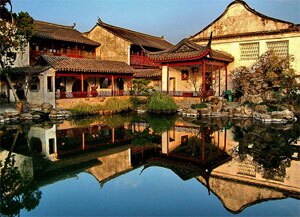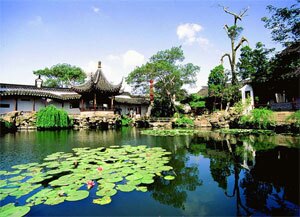 Suzhou is known for its handful of stunning classical Chinese gardens with The Garden of the Master of Nets standing out among the top 4 properties. It is found in southeast Suzhou and regarded as an ideal example in all of China, named a UNESCO World Heritage Site, a scenic spot with national 4A level, and considered a historical and cultural relic under state protection.
Suzhou is known for its handful of stunning classical Chinese gardens with The Garden of the Master of Nets standing out among the top 4 properties. It is found in southeast Suzhou and regarded as an ideal example in all of China, named a UNESCO World Heritage Site, a scenic spot with national 4A level, and considered a historical and cultural relic under state protection.
Traditional Chinese landscape design is based on creating flowing natural sceneries that pass beautifully before observers’ eyes as they move through the layout. Typically, these areas are enclosed by a wall, containing the garden’s energy, and includes water bodies and movements such as ponds and creeks, rockeries, carefully placed trees, and flowers, all working alongside human-made halls, pavilions, paths, and galleries. A Chinese landscape is not meant to be seen all at once, but in pieces that all the same lie harmoniously with its neighbors. That is why many classical Chinese gardens have names for each "scene" or area of the landscape.
The beautiful Garden of the Master of Nets was founded in the Southern Song Dynasty in the year 1174 by an imperial court member named Shi Zhengzhi in retirement. It was a private sanctuary and held thousands of Zhengzhi’s books which is how it earned its other name, Ten Thousand Volume Hall. For a while the garden fell into disarray due to negligence but was brought back to life in the Qing Dynasty.
 The Garden of the Master of Nets is about 5,333 square meters and consists of 3 main parts: a housing area featuring mansions, a landscape scenery area, and an inner garden. Indeed, there are gardens within this garden! The housing/residential area was built based on strict theory rules of its time. The front door is famous for its unique decoration indicating the owner’s rank in court. Inside are various halls, lined up along a north-south axis as common in China, each with a link to the central garden. The landscape and main garden area has a large central pond ringed with verandas and walkways. There is a humble stone bridge named Yinjing Bridgein the pond, narrow with a width of just 1 foot. Then there is the inner garden which is the home of Dianchun Studio, of which replicas have been made and showcased at museums around the world.
The Garden of the Master of Nets is about 5,333 square meters and consists of 3 main parts: a housing area featuring mansions, a landscape scenery area, and an inner garden. Indeed, there are gardens within this garden! The housing/residential area was built based on strict theory rules of its time. The front door is famous for its unique decoration indicating the owner’s rank in court. Inside are various halls, lined up along a north-south axis as common in China, each with a link to the central garden. The landscape and main garden area has a large central pond ringed with verandas and walkways. There is a humble stone bridge named Yinjing Bridgein the pond, narrow with a width of just 1 foot. Then there is the inner garden which is the home of Dianchun Studio, of which replicas have been made and showcased at museums around the world.
The buildings are all perfectly situated with sufficient spacing between them rather than crammed into a small area. The water and stone components also add to make the area seem larger, as well as create an illusion that the garden is constantly changing and exceeding bounds while achieving total unity. There are 22 buildings to be visited today, 2 doors with detailed ornamentation, 9 parallel couplets, 15 brick and stone carvings, 32 steles, and 8 rare species of ancient trees.
Below are some of the highlights of the Garden of the Master of the Nets that visitors should not miss:
 This is a popular place from which to view the central pond. This is where you can get one of the best perspectives of the central garden and its pines and cypresses. The colors of the garden here are just tremendous and calming.
This is a popular place from which to view the central pond. This is where you can get one of the best perspectives of the central garden and its pines and cypresses. The colors of the garden here are just tremendous and calming.
A curious looking entity indeed, but this rock wall acts as a screen and offers the Barrier of Clouds terrace some privacy. It is also meant to resemble a retreat area in some mountains.
Its name comes from the flowers that grew near the cottage in the 18th century. The nearby courtyard has a mosaic floor with pretty geometric patterns.
This area is small and is found in front of an enchanting, bright courtyard garden with a single pomegranate tree planted in a large stone basin. Rockeries and bamboo line the tree on both sides.